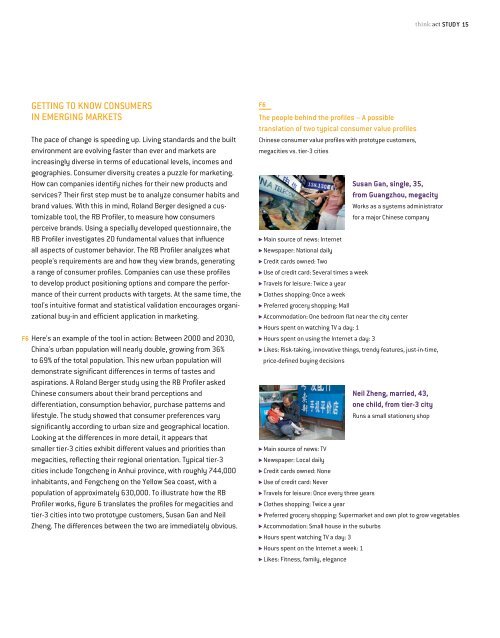How to reach emerging market consumers with new ... - Roland Berger
How to reach emerging market consumers with new ... - Roland Berger
How to reach emerging market consumers with new ... - Roland Berger
Create successful ePaper yourself
Turn your PDF publications into a flip-book with our unique Google optimized e-Paper software.
Study 15<br />
Getting <strong>to</strong> know CONSUMERS<br />
in <strong>emerging</strong> <strong>market</strong>s<br />
The pace of change is speeding up. Living standards and the built<br />
environment are evolving faster than ever and <strong>market</strong>s are<br />
increasingly diverse in terms of educational levels, incomes and<br />
geographies. Consumer diversity creates a puzzle for <strong>market</strong>ing.<br />
<strong>How</strong> can companies identify niches for their <strong>new</strong> products and<br />
services? Their first step must be <strong>to</strong> analyze consumer habits and<br />
brand values. With this in mind, <strong>Roland</strong> <strong>Berger</strong> designed a cus<strong>to</strong>miz<br />
able <strong>to</strong>ol, the RB Profiler, <strong>to</strong> measure how <strong>consumers</strong><br />
perceive brands. Using a specially developed questionnaire, the<br />
RB Profiler investigates 20 fundamental values that influence<br />
all aspects of cus<strong>to</strong>mer behavior. The RB Profiler analyzes what<br />
people's requirements are and how they view brands, generating<br />
a range of consumer profiles. Companies can use these profiles<br />
<strong>to</strong> develop product positioning options and compare the performance<br />
of their current products <strong>with</strong> targets. At the same time, the<br />
<strong>to</strong>ol's intuitive format and statistical validation encourages organizational<br />
buy-in and efficient application in <strong>market</strong>ing.<br />
f6 Here's an example of the <strong>to</strong>ol in action: Between 2000 and 2030,<br />
China's urban population will nearly double, growing from 36%<br />
<strong>to</strong> 69% of the <strong>to</strong>tal population. This <strong>new</strong> urban population will<br />
demonstrate significant differences in terms of tastes and<br />
aspirations. A <strong>Roland</strong> <strong>Berger</strong> study using the RB Profiler asked<br />
Chinese <strong>consumers</strong> about their brand perceptions and<br />
differentiation, consumption behavior, purchase patterns and<br />
lifestyle. The study showed that consumer preferences vary<br />
significantly according <strong>to</strong> urban size and geographical location.<br />
Looking at the differences in more detail, it appears that<br />
smaller tier-3 cities exhibit different values and priorities than<br />
megacities, reflecting their regional orientation. Typical tier-3<br />
cities include Tongcheng in Anhui province, <strong>with</strong> roughly 744,000<br />
inhabitants, and Fengcheng on the Yellow Sea coast, <strong>with</strong> a<br />
population of approximately 630,000. To illustrate how the RB<br />
Profiler works, figure 6 translates the profiles for megacities and<br />
tier-3 cities in<strong>to</strong> two pro<strong>to</strong>type cus<strong>to</strong>mers, Susan Gan and Neil<br />
Zheng. The differences between the two are immediately obvious.<br />
F6<br />
The people behind the profiles – A possible<br />
translation of two typical consumer value profiles<br />
Chinese consumer value profiles <strong>with</strong> pro<strong>to</strong>type cus<strong>to</strong>mers,<br />
megacities vs. tier-3 cities<br />
Susan Gan, single, 35,<br />
from Guangzhou, megacity<br />
Works as a systems administra<strong>to</strong>r<br />
for a major Chinese company<br />
Main source of <strong>new</strong>s: Internet<br />
Newspaper: National daily<br />
Credit cards owned: Two<br />
Use of credit card: Several times a week<br />
Travels for leisure: Twice a year<br />
Clothes shopping: Once a week<br />
Preferred grocery shopping: Mall<br />
Accommodation: One bedroom flat near the city center<br />
Hours spent on watching TV a day: 1<br />
Hours spent on using the Internet a day: 3<br />
Likes: Risk-taking, innovative things, trendy features, just-in-time,<br />
price-defined buying decisions<br />
Neil Zheng, married, 43,<br />
one child, from tier-3 city<br />
Runs a small stationery shop<br />
Main source of <strong>new</strong>s: TV<br />
Newspaper: Local daily<br />
Credit cards owned: None<br />
Use of credit card: Never<br />
Travels for leisure: Once every three years<br />
Clothes shopping: Twice a year<br />
Preferred grocery shopping: Super<strong>market</strong> and own plot <strong>to</strong> grow vegetables<br />
Accommodation: Small house in the suburbs<br />
Hours spent watching TV a day: 3<br />
Hours spent on the Internet a week: 1<br />
Likes: Fitness, family, elegance
















